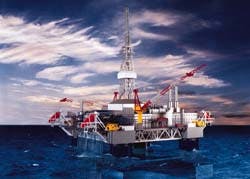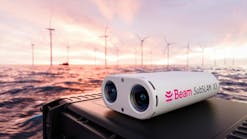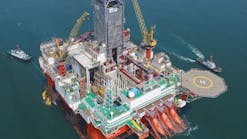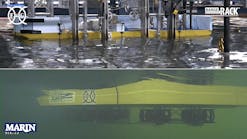Semisubmersible re-think clinches Njord EPC contract for Aker
Artist's impression of the Njord production platform at work in the Haltenbanken.
Totally new floater concepts can take years to bring to the market, except in Norway, where tastes are less diehard. Aker has managed it in just nine months with the P45 FDPU.
Norsk Hydro has chosen this new design for the Njord Field semisubmersible drilling and production platform. It is also a strong candidate for Visund and other medium-size or deepwater fields in the North Sea and beyond.
In 1993, Aker was one of the group chosen to submit a semisubmersible concept for Njord. Aker found that designing out features of its standard H-4.2 semi to make it suitable for stationary production would be more expensive than designing a completely new platform.
Norsk Hydro accepted this line on condition, amongst other things, that Aker finance the concept development itself. This it did, completing the work after 40,000 manhours last summer. This April, P45 won the day against the GVA 5000E alternative, and Aker also clinched the construction contract.
Practicalities
Norsk Hydro wanted an EPC delivery for the Njord platform, which meant the design had to be fabrication driven, and practical. Characteristics of drilling semis that would be valueless on a stationary production platform had to be dispensed with: that meant, for instance, replacing the round-shaped pontoons that reduce drag on drilling semis with prismatic boxes which cost less to build. Flexibility was also a stated aim: the design had to allow construction of platform elements at different yards. Above all, it had to be affordable.
Initial cost estimates led to a simple two-pontoon hull configuration being chosen for the P45. The deck structure, derived from Aker's PM design, comprises a flat deck supported by truss work which is configured like a square doughnut, as Aker puts it: three above deck transverse bulkheads provide deck support between the trusses and fire wall separation between process drilling and utility areas.
Unconventionally for a semi, the P45 has forward and aft pontoons to permit either connection for a large number of risers on the pontoon below the process area, or direct hang-off from the process deck.
Aker had the design tested in the Marintek model tank and the BMT wind tunnel. Tests showed that in a 100 knot wind, the floater would have an inclination angle of 11.6 in equilibrium condition. Should damage occur such as flooding of the inner column, that angle would be 16.6 in a 50 knot wind.
For Njord's 350-metre water depth and weather conditions, a 12-line mooring system was chosen comprising three segments: 111mm stud link K4 chain, 122mm spiral strand wire rope, and studless K4 chain. This is a grouped system with a 7.5 angle between the three lines connected at each column. Pre-tension for each line is 1,000kN.
The platform's flexible risers are pulled through guide tubes at pontoon level, and tied in at deck level adjacent to the manifolds, avoiding the need for below deck flowline piping.
Topside production facilities follow these key Norsk Hydro criteria: minimum space, weight and cost; low manning and low system complexity; 20MW gas turbine drive for gas reinjection compressors.
There is a three-stage separation train, with produced water removed at the second stage. Oil goes through pumps and pipeline to an offloading and storage tanker, with produced gas from the second and third stage separators recompressed in three stages and combined with gas from the first stage separator. That combined gasflow is then reinjected into the reservoir through two-stage compression.
For the P45's drilling facilities, Aker chose where possible existing equipment and technology proven on traditional semis. To meet automation and reduced manning requirements, there is a two-man cabin on the drill floor and a centralized mud area control rooms. The well control system comprises a BOP stack with mud riser, diverter with valves, choke/kill manifold, mud gas separator and trip tank with pump.
Workshops, offices and central control room are concentrated in one area close to the three-level living quarters, which has 30 single cabins for permanent staff and 45 doubles for drilling and temporary maintenance crews.
The platform incorporates two fire water ring main with capacity of 2,600 cu meters, pressurized by the seawater system. Water fog units replace the traditional sprinkler system.
Copyright 1995 Offshore. All Rights Reserved.





